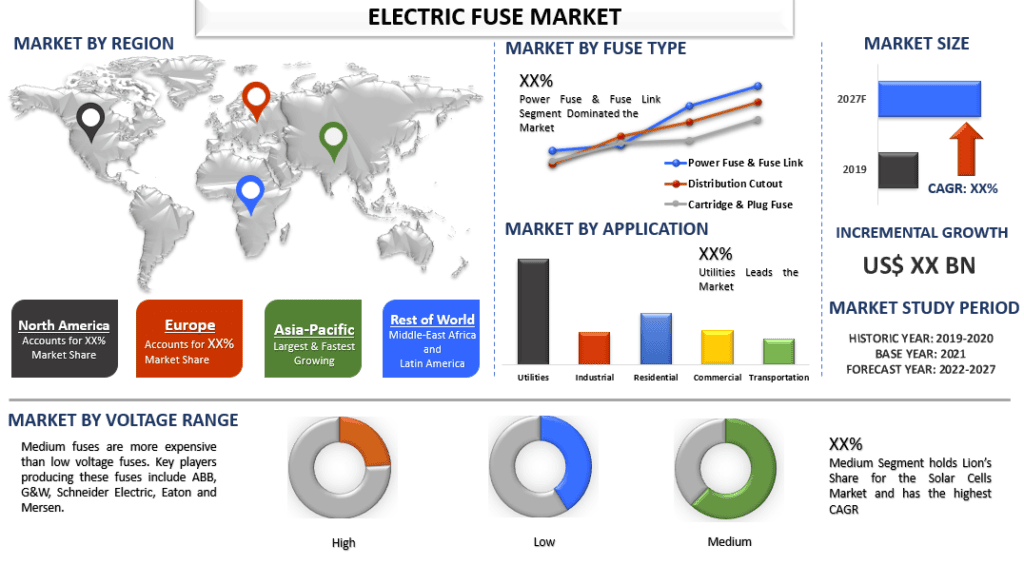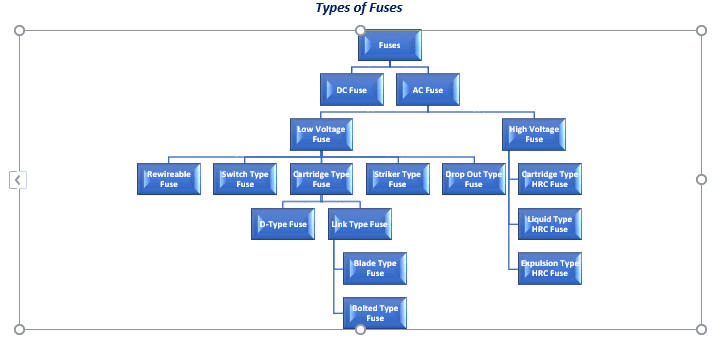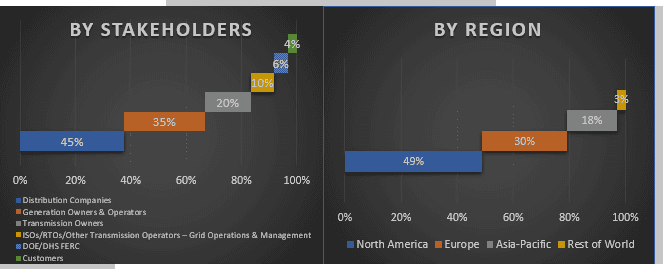- الرئيسية
- معلومات عنا
- صناعة
- الخدمات
- قراءة
- اتصل بنا
سوق الصمامات الكهربائية: التحليل الحالي والتوقعات (2021-2027)
التركيز على نوع المصهر (مصهر الطاقة & وصلة المصهر، قاطع التوزيع، الخرطوشة & مصهر القابس)؛ نطاق الجهد (منخفض، متوسط، عالي)؛ التطبيق (المرافق، الصناعية، السكنية، التجارية، النقل)؛ المنطقة والدولة
 بلغت قيمة سوق فتيل كهربائي فتيل كهربائي 3.5 مليار دولار أمريكي في عام 2020 ومن المتوقع أن ينمو بمعدل نمو سنوي مركب قدره 6٪ خلال الفترة المتوقعة (2021-2027). المصهر هو جهاز أمان كهربائي يحمي الدائرة الكهربائية من التيار الكهربائي الزائد. تتمتع المصهرات الكهربائية بتاريخ طويل. لقد تم استخدامها على نطاق واسع لكل من أنظمة الطاقة ذات الجهد العالي والجهد المنخفض. يمثل ما قبل القوس I-t (التيار مقابل الوقت) معلمة مهمة للمصهر الكهربائي. تقليديا، يتم تصميم المصهر الكهربائي عن طريق التجربة ثم يتم الحصول على خصائص I-t من خلال التجارب. المصهر هو نقطة ضعف متعمدة في الدائرة. إنه جهاز مسؤول حرارياً ومصمم لتوفير الحماية من التيار الزائد. يتم استخدام المصهر لحماية المعدات والموصلات من التلف الزائد ويمكنه بسرعة إزالة تنشيط الدوائر المعطلة مما يساعد على تقليل المخاطر على الأفراد. المصهرات من أنواع عديدة مثل سريعة المفعول أو التأخير الزمني أو تحديد التيار وعدم تحديد التيار.
بلغت قيمة سوق فتيل كهربائي فتيل كهربائي 3.5 مليار دولار أمريكي في عام 2020 ومن المتوقع أن ينمو بمعدل نمو سنوي مركب قدره 6٪ خلال الفترة المتوقعة (2021-2027). المصهر هو جهاز أمان كهربائي يحمي الدائرة الكهربائية من التيار الكهربائي الزائد. تتمتع المصهرات الكهربائية بتاريخ طويل. لقد تم استخدامها على نطاق واسع لكل من أنظمة الطاقة ذات الجهد العالي والجهد المنخفض. يمثل ما قبل القوس I-t (التيار مقابل الوقت) معلمة مهمة للمصهر الكهربائي. تقليديا، يتم تصميم المصهر الكهربائي عن طريق التجربة ثم يتم الحصول على خصائص I-t من خلال التجارب. المصهر هو نقطة ضعف متعمدة في الدائرة. إنه جهاز مسؤول حرارياً ومصمم لتوفير الحماية من التيار الزائد. يتم استخدام المصهر لحماية المعدات والموصلات من التلف الزائد ويمكنه بسرعة إزالة تنشيط الدوائر المعطلة مما يساعد على تقليل المخاطر على الأفراد. المصهرات من أنواع عديدة مثل سريعة المفعول أو التأخير الزمني أو تحديد التيار وعدم تحديد التيار.
تشمل الأسباب الرئيسية لنمو الصناعة نمو الصناعات كثيفة الاستهلاك للطاقة والتي تتطلب كميات كبيرة من الوقود والكهرباء لتشغيل المحركات الميكانيكية والأفران والمراجل والتهوية والتدفئة وأنظمة تكييف الهواء (HVAC) وما إلى ذلك. تقليديا، استخدمت الصناعات محركات IC والأفران والمراجل التي تعمل بالوقود الأحفوري من بين مصادر الطاقة غير الكهربائية الأخرى. تتجه معظم الصناعات نحو الكهربة مع التحرك العالمي نحو استخدام مستقبل منخفض الكربون ولضمان عمليات موثوقة. مع هذه الزيادة في استخدام الكهرباء، يتزايد أيضًا استخدام المصهر الكهربائي، مما يؤثر على نمو السوق. وفقًا لتقرير عام 2017 "دراسة مستقبل الكهربة" الصادر عن المختبر الوطني للطاقة المتجددة (NREL)، يتم حاليًا تلبية 25% فقط من إجمالي الطلب العالمي على الطاقة عن طريق الكهرباء. وفقًا لإدارة معلومات الطاقة الأمريكية، من المتوقع أن تزيد صناعة الآلات من استخدامها للكهرباء بنسبة تصل إلى 13% وصناعة المنتجات الكهربائية والبلاستيكية بنسبة 8% بحلول عام 2050. وتلبي بعض الصناعات مثل صناعة المنتجات الكهربائية والآلات وأجهزة الكمبيوتر بالفعل ما يصل إلى 50% من احتياجاتها من الطاقة عن طريق الكهرباء. هذا الاستخدام المتزايد للكهرباء في جميع أقسام الصناعات يؤثر على نمو سوق المصهرات الكهربائية.
أنواع المصهرات

تعد Littelfuse, Inc. وABB Ltd. وMersen S.A. وSchneider Electric SE وBel Fuse Inc. وBourns Inc. وSCHURTER AG وEaton Corporation Plc وSiemens AG وSIBA GmbH من بين اللاعبين البارزين العاملين في سوق المصهرات الكهربائية. لقد قامت هذه الشركات بالعديد من عمليات الاندماج والاستحواذ إلى جانب الشراكات لتزويد العملاء بمنتجات/تقنيات مبتكرة وعالية التقنية.
الرؤى المقدمة في التقرير
"من بين أنواع المصهرات، تستحوذ فئة مصهرات الطاقة ووصلة المصهر على الحصة الأكبر"
استنادًا إلى نوع المصهر، يتم تقسيم سوق المصهرات الكهربائية إلى مصهرات الطاقة ووصلة المصهر، وقاطع التوزيع، والمصهر الخرطوشة والقابس. من بين أنواع المصهرات، قُدرت قيمة فئة مصهرات الطاقة ووصلات المصهر في السوق بمبلغ XX مليون دولار أمريكي في عام 2020 ومن المرجح أن تصل إلى XX مليون دولار أمريكي بحلول عام 2027، لتنمو بمعدل نمو سنوي مركب قدره XX% من 2021 إلى 2027. وهي بشكل عام مصهرات ذات جهد متوسط بتصنيف بين 1.5 كيلو فولت و 63 كيلو فولت. تستخدم بشكل رئيسي في شبكات النقل والتوزيع وحماية الدوائر والمحركات والمحولات والتطبيقات الصناعية وتوليد وتوزيع الطاقة المتجددة.
"من بين نطاقات الجهد، تستحوذ الفئة المتوسطة على الحصة الأكبر"
استنادًا إلى نطاق الجهد، يتم تقسيم سوق المصهرات الكهربائية إلى منخفض ومتوسط وعالي. من بين نطاقات الجهد، استحوذت الفئة المتوسطة على تقييم سوقي قدره XX مليون دولار أمريكي في عام 2020 ومن المتوقع أن تصل إلى XX مليون دولار أمريكي بحلول عام 2027، بمعدل نمو سنوي مركب قدره XX% خلال الفترة التي تم تحليلها. المصهرات ذات نطاق الجهد المتوسط هي مصهرات لديها القدرة على فتح الدوائر في نطاق جهد أعلى من 1 إلى 38 كيلو فولت. هناك طلب كبير على المصهرات ذات الجهد المتوسط بسبب البناء المستمر لشبكات النقل والتوزيع جنبًا إلى جنب مع إمكانية استبدال المصهرات العالية.
"من بين التطبيقات، تستحوذ فئة المرافق على الحصة الأكبر"
استنادًا إلى التطبيق، يتم تقسيم سوق المصهرات الكهربائية إلى المرافق والصناعة والمنازل والتجارية والنقل. حققت فئة المرافق إيرادات قدرها XX مليون دولار أمريكي في عام 2020 ومن المتوقع أن تنمو بمعدل نمو سنوي مركب قدره XX% خلال الفترة المتوقعة لتصل إلى تقييم سوقي قدره XX مليون دولار أمريكي بحلول عام 2027F. يجب على المرافق إدارة الشبكات وتوفير طاقة موثوقة وآمنة. وبالتالي، فإن الطلب على المصهرات موجود حتى مع وجود بدائل.
"تمثل منطقة آسيا والمحيط الهادئ واحدة من أكبر أسواق سوق المصهرات الكهربائية"
لفهم أفضل لديناميكيات سوق سوق المصهرات الكهربائية، تم إجراء تحليل مفصل لمختلف المناطق في جميع أنحاء العالم بما في ذلك أمريكا الشمالية (الولايات المتحدة وكندا وبقية أمريكا الشمالية) وأوروبا (ألمانيا وفرنسا وإيطاليا والمملكة المتحدة وإسبانيا وبقية أوروبا) وآسيا والمحيط الهادئ (الصين واليابان والهند وأستراليا وبقية منطقة آسيا والمحيط الهادئ) وبقية العالم. هيمنت منطقة آسيا والمحيط الهادئ على السوق واستحوذت على حصة سوقية تبلغ حوالي XX% بسبب التصنيع المتزايد في المنطقة.
أسباب شراء هذا التقرير:
- تتضمن الدراسة تحليل حجم السوق والتنبؤ به والذي تم التحقق منه من قبل خبراء الصناعة الرئيسيين الموثوقين
- يقدم التقرير مراجعة سريعة للأداء العام للصناعة في لمحة
- يغطي التقرير تحليلاً متعمقًا لنظراء الصناعة البارزين مع التركيز الأساسي على البيانات المالية الرئيسية للأعمال ومجموعة المنتجات واستراتيجيات التوسع والتطورات الحديثة
- فحص تفصيلي للدوافع والقيود والاتجاهات الرئيسية والفرص السائدة في الصناعة
- تغطي الدراسة بشكل شامل السوق عبر قطاعات مختلفة
- تحليل إقليمي متعمق للصناعة
خيارات التخصيص:
يمكن تخصيص سوق المصهرات الكهربائية بشكل أكبر حسب المتطلبات أو أي قطاع سوقي آخر. إلى جانب ذلك، تتفهم UMI أن لديك احتياجات عمل خاصة بك، لذا لا تتردد في التواصل معنا للحصول على تقرير يناسب متطلباتك تمامًا.
جدول المحتويات
كان تحليل السوق التاريخي وتقدير السوق الحالي والتنبؤ بالسوق المستقبلي لسوق فتيل الكهرباء هي الخطوات الرئيسية الثلاث التي تم اتخاذها لإنشاء وتحليل اعتماد فتيل الكهرباء في المناطق الرئيسية على مستوى العالم. تم إجراء بحث ثانوي شامل لجمع أرقام السوق التاريخية وتقدير حجم السوق الحالي. ثانيًا، للتحقق من صحة هذه الأفكار، تم أخذ العديد من النتائج والافتراضات في الاعتبار. علاوة على ذلك، تم إجراء مقابلات أولية شاملة أيضًا مع خبراء الصناعة عبر سلسلة القيمة لسوق فتيل الكهرباء. بعد افتراض والتحقق من صحة أرقام السوق من خلال المقابلات الأولية، استخدمنا منهجًا تصاعديًا/تنازليًا للتنبؤ بحجم السوق الكامل. بعد ذلك، تم اعتماد طرق تقسيم السوق وتثليث البيانات لتقدير وتحليل حجم السوق للقطاعات والقطاعات الفرعية التي تنتمي إليها الصناعة. يتم شرح المنهجية التفصيلية أدناه:
تحليل حجم السوق التاريخي
الخطوة 1: دراسة متعمقة للمصادر الثانوية:
تم إجراء دراسة ثانوية تفصيلية للحصول على حجم السوق التاريخي لـ فتيل الكهرباء من خلال مصادر الشركة الداخلية مثل التقرير السنوي & البيانات المالية وعروض الأداء والنشرات الصحفية وما إلى ذلك، والمصادر الخارجية بما في ذلك المجلات والأخبار & المقالات والمنشورات الحكومية ومنشورات المنافسين وتقارير القطاعات وقاعدة بيانات الطرف الثالث والمنشورات الموثوقة الأخرى.
الخطوة 2: تقسيم السوق:
بعد الحصول على حجم السوق التاريخي لسوق فتيل الكهرباء، أجرينا تحليلًا ثانويًا تفصيليًا لجمع رؤى السوق التاريخية ومشاركتها لقطاعات فرعية مختلفة & قطاعات فرعية للمناطق الرئيسية. تشمل القطاعات الرئيسية المدرجة في التقرير نوع الفتيل ونطاق الجهد والتطبيق. تم إجراء المزيد من التحليلات على المستوى القطري لتقييم الاعتماد الكلي لـ فتيل الكهرباء في تلك المنطقة.
الخطوة 3: تحليل العوامل:
بعد الحصول على حجم السوق التاريخي للقطاعات والقطاعات الفرعية المختلفة، أجرينا تحليل عوامل مفصل لتقدير حجم السوق الحالي لـ فتيل الكهرباء. علاوة على ذلك، أجرينا تحليلًا للعوامل باستخدام متغيرات تابعة ومستقلة مثل التصنيع في البلدان النامية وزيادة معدل توليد الطاقة على مر السنين. تم إجراء تحليل شامل لسيناريوهات الطلب والعرض مع مراعاة أهم الشراكات وعمليات الاندماج والاستحواذ والتوسع التجاري وإطلاق المنتجات في قطاع فتيل الكهرباء في جميع أنحاء العالم.
تقدير حجم السوق الحالي & التنبؤ
تحديد حجم السوق الحالي: استنادًا إلى رؤى قابلة للتنفيذ من الخطوات الثلاث المذكورة أعلاه، توصلنا إلى حجم السوق الحالي واللاعبين الرئيسيين في سوق فتيل الكهرباء والحصص السوقية للقطاعات. تم تحديد جميع تقسيمات الأسهم النسبية المطلوبة وتقسيمات السوق باستخدام النهج الثانوي المذكور أعلاه وتم التحقق منها من خلال المقابلات الأولية.
التقدير & التنبؤ: لتقدير السوق والتنبؤ به، تم تعيين أوزان لعوامل مختلفة بما في ذلك المحركات & الاتجاهات والقيود والفرص المتاحة لأصحاب المصلحة. بعد تحليل هذه العوامل، تم تطبيق تقنيات التنبؤ ذات الصلة، أي النهج التصاعدي/التنازلي للوصول إلى توقعات السوق حول عام 2027 للقطاعات والقطاعات الفرعية المختلفة عبر الأسواق الرئيسية على مستوى العالم. تشتمل منهجية البحث المعتمدة لتقدير حجم السوق على:
- حجم سوق الصناعة، من حيث القيمة (بالدولار الأمريكي) ومعدل اعتماد فتيل الكهرباء عبر الأسواق الرئيسية محليًا
- جميع الأسهم النسبية والتقسيمات والتحليلات التفصيلية لقطاعات السوق والقطاعات الفرعية
- اللاعبون الرئيسيون في سوق فتيل الكهرباء من حيث المنتجات المعروضة. أيضًا، استراتيجيات النمو التي يتبناها هؤلاء اللاعبون للتنافس في السوق سريع النمو
التحقق من صحة حجم السوق والحصة السوقية
البحث الأولي: تم إجراء مقابلات متعمقة مع قادة الرأي الرئيسيين (KOLs) بمن فيهم كبار المسؤولين التنفيذيين (CXO/VPs ورئيس المبيعات ورئيس التسويق والرئيس التشغيلي والرئيس الإقليمي ورئيس الدولة وما إلى ذلك) في المناطق الرئيسية. ثم تم تلخيص نتائج البحث الأولي وإجراء تحليل إحصائي لإثبات الفرضية المذكورة. تم دمج المدخلات من البحث الأولي مع النتائج الثانوية، وبالتالي تحويل المعلومات إلى رؤى قابلة للتنفيذ.
تقسيم المشاركين الأوليين في مناطق مختلفة

هندسة السوق
تم استخدام تقنية تثليث البيانات لإكمال تقدير السوق الإجمالي والوصول إلى أرقام إحصائية دقيقة لكل قطاع وقطاع فرعي من سوق فتيل الكهرباء. تم تقسيم البيانات إلى عدة قطاعات & قطاعات فرعية بعد دراسة المعلمات والاتجاهات المختلفة في مجالات النوع ونوع سوق فتيل الكهرباء.
الهدف الرئيسي لدراسة سوق فتيل الكهرباء
تم تحديد اتجاهات السوق الحالية والمستقبلية لـ فتيل الكهرباء في الدراسة. يمكن للمستثمرين الحصول على رؤى استراتيجية لترسيخ تقديرهم للاستثمارات من التحليل النوعي والكمي الذي تم إجراؤه في الدراسة. تم تحديد اتجاهات السوق الحالية والمستقبلية والجاذبية الإجمالية للسوق على المستوى الإقليمي، مما يوفر منصة للمشارك الصناعي لاستغلال السوق غير المستغلة للاستفادة كميزة المحرك الأول. تشمل الأهداف الكمية الأخرى للدراسات ما يلي:
- تحليل حجم السوق الحالي والمتوقع لـ فتيل الكهرباء من حيث القيمة (بالدولار الأمريكي). أيضًا، قم بتحليل حجم السوق الحالي والمتوقع للقطاعات والقطاعات الفرعية المختلفة
- تشمل القطاعات في الدراسة مجالات النوع وأنواعه الفرعية
- تحديد وتحليل الإطار التنظيمي لصناعة فتيل الكهرباء
- تحليل سلسلة القيمة المعنية بوجود وسطاء مختلفين، إلى جانب تحليل سلوكيات العملاء والمنافسين في الصناعة
- تحليل حجم السوق الحالي والمتوقع لسوق فتيل الكهرباء للمنطقة الرئيسية
- تشمل المناطق الرئيسية التي تمت دراستها في التقرير أمريكا الشمالية (الولايات المتحدة وكندا وبقية أمريكا الشمالية) وأوروبا (ألمانيا والمملكة المتحدة وفرنسا وإسبانيا وإيطاليا وبقية أوروبا) وآسيا والمحيط الهادئ (الصين واليابان والهند وأستراليا ودول أخرى) وبقية دول العالم
- ملفات تعريف الشركة لسوق فتيل الكهرباء واستراتيجيات النمو التي يتبناها اللاعبون في السوق للحفاظ على النمو في السوق سريع النمو
تحليل متعمق على المستوى الإقليمي للصناعة
ذات صلة التقارير
العملاء الذين اشتروا هذا المنتج اشتروا أيضًا










